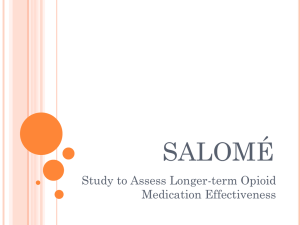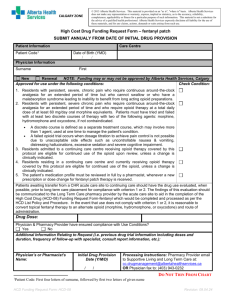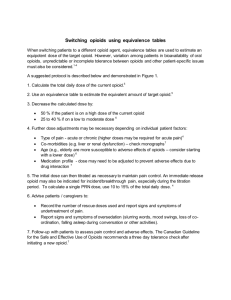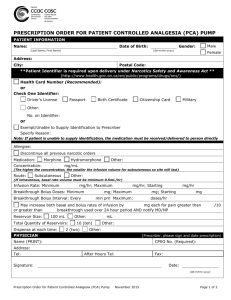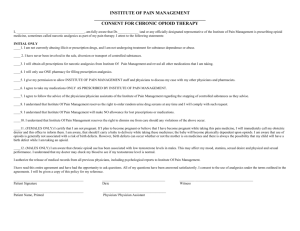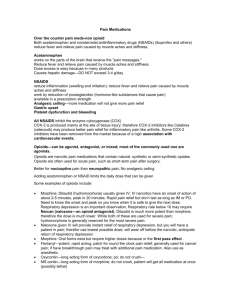HYDROmorphone Hydrochloride Injection USP
advertisement
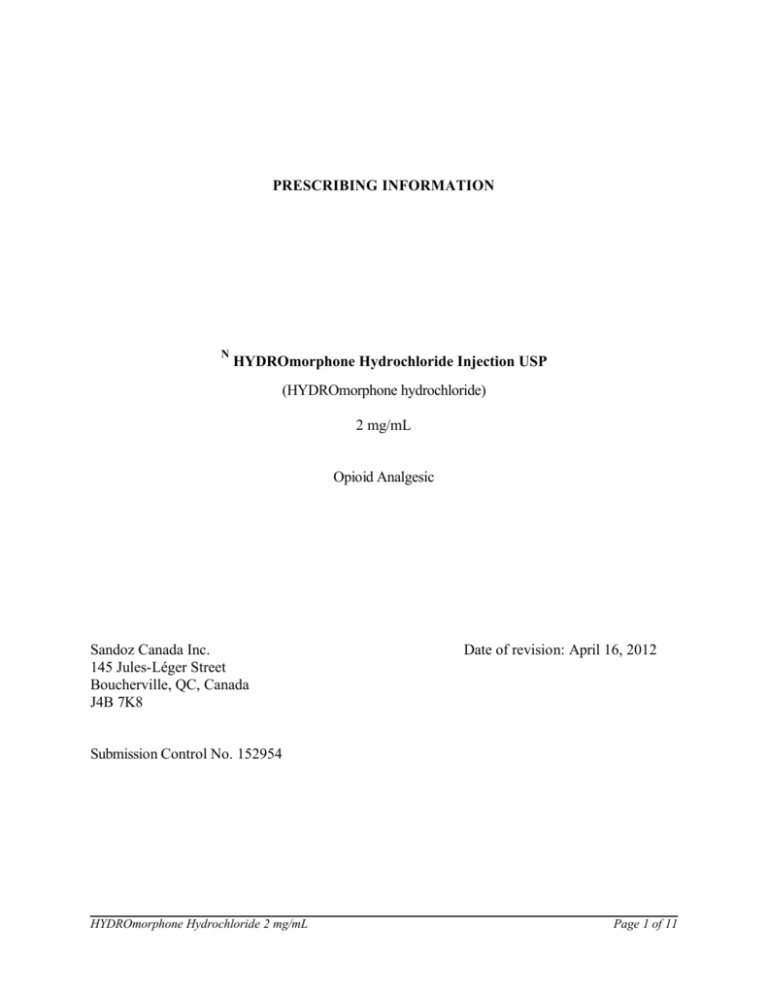
PRESCRIBING INFORMATION N HYDROmorphone Hydrochloride Injection USP (HYDROmorphone hydrochloride) 2 mg/mL Opioid Analgesic Sandoz Canada Inc. 145 Jules-Léger Street Boucherville, QC, Canada J4B 7K8 Date of revision: April 16, 2012 Submission Control No. 152954 HYDROmorphone Hydrochloride 2 mg/mL Page 1 of 11 N HYDROmorphone Hydrochloride Injection USP 2 mg/mL (HYDROmorphone hydrochloride) THERAPEUTIC CLASSIFICATION Opioid Analgesic ACTION AND CLINICAL PHARMACOLOGY HYDROmorphone hydrochloride has strong analgesic and antitussive activity. Small doses of HYDROmorphone produce effective and prompt relief of pain, usually with minimal nausea and vomiting. When given parenterally, HYDROmorphone's analgesic action is generally apparent within five minutes. The onset of action of oral HYDROmorphone hydrochloride is somewhat slower, with measurable analgesia occurring within 30 minutes. When sleep follows the administration of HYDROmorphone, it is usually due to relief of pain, not to hypnosis. HYDROmorphone is approximately 8 times more potent on a milligram basis than morphine. In addition, HYDROmorphone is better absorbed orally than is morphine, the former approximately 20 to 25% as active orally as IM HYDROmorphone has greater antitussive potency than codeine on a weight basis; however, its dependence liability is also greater than that of codeine. After absorption, HYDROmorphone is metabolized by the liver to the glucuronide conjugate which is then excreted in the urine. INDICATIONS AND CLINICAL USE HYDROmorphone Hydrochloride Injection USP is indicated for the relief of moderate to severe pain. For post-operative relief of pain. CONTRAINDICATIONS HYDROmorphone hydrochloride is contraindicated in patients with known hypersensitivity to the drug; patients with respiratory depression in the absence of resuscitative equipment; in patients with severe CNS depression; patients with intracranial lesions associated with increased intracranial pressure; patients with status asthmaticus; patients with pulmonary edema. WARNINGS Drug Dependence All opioids, like morphine and HYDROmorphone hydrochloride can produce drug dependence HYDROmorphone Hydrochloride 2 mg/mL Page 2 of 11 and therefore have the potential for being abused. As with other opioid drugs, psychic dependence, physical dependence and tolerance are likely to develop upon repeated administration of HYDROmorphone, and it should be prescribed and administered with the same degree of caution appropriate for the use of morphine. Abrupt discontinuation of the administration of HYDROmorphone is likely to result in a withdrawal syndrome - (See PRECAUTIONS - Dependence Liability). Infants born to mothers physically dependent on HYDROmorphone will also be physically dependent and may exhibit respiratory difficulties and withdrawal symptoms (See PRECAUTIONS -Dependence Liability). Impaired Respiration Respiratory depression is the chief hazard of HYDROmorphone. It occurs most frequently in overdose, the elderly, in the debilitated, and in those suffering from conditions accompanied by hypoxia or hypercapnia, when even moderate therapeutic doses may dangerously decrease pulmonary ventilation. This effect may be lessened by careful dose titration as severe pain can antagonize the respiratory depressant action of HYDROmorphone. HYDROmorphone should be used with extreme caution in patients with chronic obstructive pulmonary disease or cor pulmonale, patients having a substantially decreased respiratory reserve, hypoxia, hypercapnia, or pre-existing respiratory depression. In such patients, even the usual therapeutic doses of opioid analgesics may decrease respiratory drive while simultaneously increasing airway resistance, to the point of apnea. As mentioned above, severe pain antagonizes the subjective and respiratory depressant actions of HYDROmorphone. However, should pain suddenly subside, these effects may rapidly become manifest. Patients who are scheduled for cordotomy or other interruptions of pain transmission pathways should not receive HYDROmorphone within 24 hours of the procedure. Hypotensive Effect Opioid analgesics, including HYDROmorphone, may cause severe hypotension in individuals whose ability to maintain normal blood pressure has already been compromised by depleted blood volume, or the concurrent administration of drugs such as phenothiazines and other tranquilizers, sedative/hypnotics, tricyclic antidepressants or general anesthetics (see also PRECAUTIONS Drug Interactions). HYDROmorphone may produce orthostatic hypotension in ambulatory patients. HYDROmorphone should be administered with caution to patients in circulatory shock, since vasodilation produced by the drug may further reduce cardiac output and blood pressure. Rapid intravenous injection of opioid analgesics increases the possibility of hypotension and respiratory depression and should be avoided (see DOSAGE AND ADMINISTRATION). Use in Pregnancy (see WARNINGS - Drug Dependence) Animals: Adequate animal studies on reproduction have not been performed to determine whether HYDROmorphone Hydrochloride 2 mg/mL Page 3 of 11 HYDROmorphone affects fertility in males or females. However, animal studies with both morphine and HYDROmorphone have indicated the possibility of teratogenic effects. Humans: There are no well-controlled studies in women. Reports based on marketing experience do not identify any specific teratogenic risks following routine (short-term) clinical use. Although there is no clearly defined risk, such reports do not exclude the possibility of infrequent or subtle damage to the human fetus. HYDROmorphone should be used in pregnant women only when clearly needed (see Labor and Delivery and Dependence Liability). PRECAUTIONS General In diseases, such as malignant cancers, where pain control is the primary focus opioid administration at very high doses is associated with seizures and myoclonus. If necessary, HYDROmorphone may be given IV but the injection should be given very slowly. Rapid IV injection of narcotic analgesic agents, including HYDROmorphone, increases the possibility of adverse effects, such as hypotension and respiratory depression. Special Risk Groups In general, opioids should be given with caution and the initial dose should be reduced for the elderly or debilitated, and those with severe impairment of hepatic, pulmonary or renal function; myxedema or hypothyroidism; adrenocortical insufficiency (i.e. Addison's disease); CNS depression or coma; elevated intracranial pressure; toxic psychosis; prostatic hypertrophy or urethral stricture; gallbladder disease; acute alcoholism; delirium tremens; or kyphoscoliosis. The administration of opioid analgesics including HYDROmorphone may obscure the diagnosis or clinical course in patients with acute abdominal conditions. Opioid analgesics including HYDROmorphone should also be used with caution in patients about to undergo surgery of the biliary tract, since it may cause spasm of the sphincter of Oddi. Dependence Liability Opioid analgesics may cause psychological and physical dependence (see WARNINGS). Physical dependence results in withdrawal symptoms in patients who abruptly discontinue the drug. Withdrawal symptoms may also be precipitated in the patient with physical dependency by the administration of a drug with opioid antagonist activity, i.e. naloxone or mixed agonist antagonists i.e. pentazocine (see also OVERDOSAGE). Physical dependence usually does not occur to a clinically significant degree until after several weeks of continued opioid usage. Tolerance, in which increasingly large doses are required in order to produce the same degree of analgesia, is initially manifested by a shortened duration of analgesic effect and subsequently, by decreases in the intensity of analgesia. The dose required to produce analgesia is, therefore, related to the degree of tolerance. In chronic pain patients in whom opioid analgesics are abruptly discontinued, a severe abstinence HYDROmorphone Hydrochloride 2 mg/mL Page 4 of 11 syndrome should be anticipated. This may be similar to the abstinence syndrome noted in patients withdrawing from heroin. The latter abstinence syndrome may be characterized by restlessness, lacrimation, rhinorrhea, yawning, perspiration, gooseflesh, restless sleep or "yen", and a mydriasis during the first 24 hours. Those symptoms may increase in severity and over the next 72 hours may be accompanied by increasing irritability, anxiety, weakness, twitching and spasms of muscles, kicking movements, severe backache, abdominal and leg pains, abdominal and muscle cramps, hot and cold flashes, insomnia, nausea, anorexia, vomiting, intestinal spasm, diarrhea, coryza and repetitive sneezing, increase in body temperature, blood pressure, respiratory rate and heart rate. Because of the excessive loss of fluids through sweating, or vomiting and diarrhea, there is usually marked weight loss, dehydration, ketosis, and disturbances in acid-base balance. Cardiovascular collapse can occur. Without treatment, most observable symptoms disappear in 5 to 14 days; however, there appears to be a phase of secondary or chronic abstinence which may last for 2 to 6 months and is characterized by insomnia, irritability, muscular aches, and autonomic instability. In the treatment of physical dependence on HYDROmorphone, the patient may be detoxified by gradual reduction of the dosage, although this is unlikely to be necessary in the terminal cancer patient. If abstinence symptoms become severe, the patient may be given methadone. Temporary administration of tranquilizers and sedatives may aid in reducing patient anxiety. Gastrointestinal disturbances or dehydration should be treated accordingly. HYDROmorphone hydrochloride should be used with caution in patients with alcoholism and other drug dependencies due to increased frequency of opioid tolerance and psychological dependence observed in these patient populations. Drug Interactions The concomitant use of other central nervous system depressants including sedatives or hypnotics, general anesthetics, phenothiazines, tranquilizers and alcohol may produce additive depressant effects. Respiratory depression, hypotension and profound sedation or coma may occur. When such combined therapy is contemplated, the dose of one or both agents should be reduced. Opioid analgesics, including HYDROmorphone may enhance the action of neuromuscular blocking agents and produce an increased degree of respiratory depression. Pregnancy During pregnancy, HYDROmorphone hydrochloride should be administered with caution and after the need of the mother has been considered against the risk of the child. In long-term treatment during pregnancy, the risk of neonatal withdrawal should be considered. Nursing Mothers Low levels of opioid analgesics have been detected in human milk. As a general rule, nursing should not be undertaken while a patient is receiving HYDROmorphone since it and other drugs in this class may be excreted in the milk. Pediatric Use HYDROmorphone Hydrochloride 2 mg/mL Page 5 of 11 Safety and effectiveness in children have not been established. Geriatric Use In general, dose selection for elderly patients should be cautious and the initial dose should be reduced due to the greater frequency of decreased hepatic, renal or cardiac functions and of concomitant disease or other drug therapy in these patients. Cough Reflex HYDROmorphone hydrochloride suppresses the cough reflex; as with all opioid analgesics, caution should be exercised when HYDROmorphone hydrochloride is used post-operatively in patients with pulmonary disease. Ability to Drive and Use Machines HYDROmorphone hydrochloride may impair mental and/or physical ability required for the performance of potentially hazardous tasks such as driving and operating machinery. ADVERSE REACTIONS The adverse effects of HYDROmorphone hydrochloride are similar to those of other opioid analgesics and represent an extension of pharmacological effects of the drug class. The major hazards include respiratory depression and apnea. To a lesser degree, circulatory depression, respiratory arrest, shock and cardiac arrest have occurred. The most frequently observed adverse effects are constipation, lightheadedness, dizziness, sedation, nausea, vomiting, and sweating. All of these effects, except constipation seem to be more prominent in ambulatory patients and in those not experiencing severe pain. Some adverse reactions in ambulatory patients may be alleviated if the patient lies down. When instituting prolonged therapy with an opioid for chronic pain, the prescription of antiemetics for nausea and vomiting and an appropriate regimen of bowel management for constipation (stool softeners, laxatives etc.) should be considered. Pain at injection site, local tissue irritation and induration following SC injection, particularly when repeated in the same area, have occurred. Sedation Some degree of sedation is experienced by most patients upon initiation of therapy. This may be at least partly because patients often recuperate from prolonged fatigue after the relief of persistent pain. Most patients develop tolerance to the sedative effects of opioids within three to five days and, if the sedation is not severe, will not require any treatment except reassurance. If excessive sedation persists beyond a few days, the dose of the opioid should be reduced and alternate causes investigated. Some of these are: concurrent CNS depressant medication, hepatic or renal dysfunction, brain metastases, hypercalcemia and respiratory failure. If it is necessary to reduce the dose, it can be carefully increased again after three or four days if it is obvious that the pain is not being well controlled. Dizziness and unsteadiness may be caused by postural hypotension particularly in elderly or debilitated patients and may be alleviated if the patient lies down. HYDROmorphone Hydrochloride 2 mg/mL Page 6 of 11 Nausea and Vomiting Nausea is a common side effect on initiation of therapy with opioid analgesics and is thought to occur by activation of the chemoreceptor trigger zone, stimulation of the vestibular apparatus and through delayed gastric emptying. The prevalence of nausea declines following continued treatment with opioid analgesics. When instituting prolonged therapy with an opioid for chronic pain, the routine prescription of an antiemetic should be considered. In the cancer patient, investigation of nausea should include such causes as constipation, bowel obstruction, uremia, hypercalcemia, hepatomegaly, tumor invasion of celiac plexus and concurrent use of drugs with emetogenic properties. Persistent nausea which does not respond to dosage reduction may be caused by opioidinduced gastric stasis and may be accompanied by other symptoms including anorexia, early satiety, vomiting and abdominal fullness. These symptoms respond to chronic treatment with gastrointestinal prokinetic agents. Constipation Practically all patients become constipated while taking opioids on a persistent basis. In some patients, particularly the elderly or bedridden, fecal impaction may result. It is essential to caution the patients in this regard and to institute an appropriate regimen of bowel management at the start of prolonged opioid analgesic therapy. Stool softeners, stimulant laxatives and other appropriate measures should be used as required. Less Frequently Observed with Opioid Analgesics General and CNS: Dysphoria, euphoria, weakness, headache, agitation, tremor, uncoordinated muscle movements, alterations of mood (nervousness, apprehension, depression, floating feelings, dreams), muscle rigidity, paresthesia, muscle tremor, blurred vision, nystagmus, diplopia and miosis, hallucinations and disorientation, visual disturbances, insomnia and increased intracranial pressure may occur. Cardiovascular: Flushing of the face, chills, tachycardia, bradycardia, palpitation, faintness, syncope, hypotension and hypertension have been reported. Respiratory: Bronchospasm and laryngospasm have been known to occur. Gastrointestinal: Dry mouth, constipation, biliary tract spasm, anorexia, diarrhea, cramps, ileus and taste alterations have been reported. Genitourinary: Urinary retention or hesitancy, and antidiuretic effects have been reported. Dermatologic: Pruritus, urticaria, other skin rashes, wheal and flare over the vein with intravenous injection, and diaphoresis have been reported with opioid analgesics. HYDROmorphone Hydrochloride 2 mg/mL Page 7 of 11 REPORTING SUSPECTED SIDE EFFECTS You can report any suspected adverse reactions associated with the use of health products to the Canada Vigilance Program by one of the following 3 ways: -------------------------------------------------------------------------§ Report online at www.healthcanada.gc.ca/medeffect § Call toll-free at 1-866-234-2345 § Complete a Canada Vigilance Reporting Form and: - Fax toll-free to 1-866-678-6789, or - Mail to: Canada Vigilance Program Health Canada Postal Locator 0701E Ottawa, Ontario K1A 0K9 Postage paid labels, Canada Vigilance Reporting Form and the adverse reaction reporting guidelines are available on the MedEffect™ Canada Web site at www.healthcanada.gc.ca/medeffect. NOTE: Should you require information related to the management of side effects, contact your health professional. The Canada Vigilance Program does not provide medical advice. OVERDSOSAGE For management of a suspected drug overdose, contact your regional Poison Control Centre. Symptoms: Serious overdosage with HYDROmorphone hydrochloride is characterized by respiratory depression (a decrease in respiratory rate and/or tidal volume, Cheyne -Stokes respiration, cyanosis), extreme somnolence progressing to stupor or coma, skeletal muscle flaccidity, cold and clammy skin, and sometimes bradycardia and hypotension. In severe overdosage, particularly following intravenous injection, apnea, circulatory collapse, cardiac arrest and death may occur. Treatment: In the treatment of overdosage, primary attention should be given to the reestablishment of adequate respiratory exchange through provision of a patent airway and institution of assisted or controlled ventilation. It should be borne in mind that for individuals who are physically dependent on opioids and are receiving large doses of these drugs, the administration of the usual dose of opioid antagonist will precipitate an acute withdrawal syndrome. The severity will depend on the degree of physical dependence and the dose of the antagonist administered. Use of an opioid antagonist in such persons should be avoided. If necessary to treat serious respiratory depression in the physically dependent patient, the antagonist should be administered with extreme care and by titration, commencing with 10 to 20% of the usual recommended initial dose. Respiratory depression which may result from overdosage, or unusual sensitivity to HYDROmorphone Hydrochloride 2 mg/mL Page 8 of 11 HYDROmorphone in a non-opioid-tolerant patient, can be managed with the opioid antagonist naloxone. A dose of naloxone (usually 0.4 to 2.0 mg) should be administered intravenously, if possible, simultaneously with respiratory resuscitation. The dose can be repeated in 3 minutes. Naloxone should not be administered in the absence of clinically significant respiratory or circulatory depression. Naloxone should be administered cautiously to persons who are known or suspected to be physically dependent on HYDROmorphone. In such cases, an abrupt or complete reversal of opioid effects may precipitate an acute abstinence syndrome. Since the duration of action of HYDROmorphone may exceed that of the antagonist, the patient should be kept under continued surveillance; repeated doses of the antagonist may be required to maintain adequate respiration. Other supportive measures should be applied when indicated. Supportive measures, including oxygen and vasopressors, should be employed in the management of circulatory shock and pulmonary edema accompanying overdose, as indicated. Cardiac arrest or arrhythmias may require cardiac massage or defibrillation. DOSAGE AND ADMINISTRATION Parenteral The usual adult parenteral dose for pain relief is 2 mg by SC or IM route every 4 to 6 hours as necessary. If necessary, HYDROmorphone may be given IV, but the injection should be given very slowly. Rapid intravenous injection of opioid analgesics increases the possibility of hypotension and respiratory depression. Severe pain can be controlled with 3 to 4 mg every 4 to 6 hours as necessary. HYDROmorphone hydrochloride injection has been reported to be physically or chemically incompatible with solutions containing sodium bicarbonate and thiopenthal sodium. HYDROmorphone Hydrochloride 2 mg/mL Page 9 of 11 PHARMACEUTICAL INFORMATION Drug Substance Proper Name: HYDROmorphone hydrochloride Chemical Name: (1)Morphinan-6-one,4,5-epoxy-3-hydroxy-17-methyl-, hydrochloride, (5α)-(2) 4,5α-Epoxy-3-hydroxy-17-methylmorphinan-6-one hydrochloride CH3 H CH2 N H . HCl CH2 HO O O Structural Formula: Molecular Formula: C17H19NO3·HCl Molecular Weight: 321.8 Description: HYDROmorphone hydrochloride occurs as a fine, white or practically white, crystalline powder and is freely soluble in water and sparingly soluble in alcohol. HYDROmorphone hydrochloride has a melting point of 305° - 315°C and a pKa of 8.2 at 20°C. A 1% aqueous solution of HYDROmorphone hydrochloride has a pH of 5.3. COMPOSITION Each mL of HYDROmorphone Hydrochloride Injection USP contains HYDROmorphone hydrochloride 2 mg, citric acid 2 mg, sodium citrate 2 mg, sodium chloride 7.48 mg, hydrochloric acid and /or sodium hydroxide to adjust PH, and water for injection. STORAGE AND STABILITY Store between 15 and 30°C. Protect from light. Discard unused portion. HYDROmorphone Hydrochloride 2 mg/mL Page 10 of 11 AVAILABILITY OF DOSAGE FORMS HYDROmorphone Hydrochloride Injection USP 2 mg/mL is available in 1 mL single use vials in boxes of 10 as well as 1 mL ampoules boxes of 10. HYDROmorphone Hydrochloride 2 mg/mL Page 11 of 11
